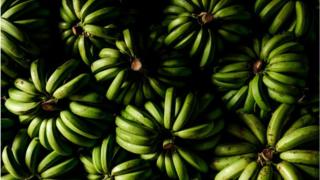Do we need to worry about banana blight?

 Image copyright Getty Images
Image copyright Getty Images News broke late last week that a fungal disease that kills Cavendish banana plants has been detected in Latin America for the first time.
A strain of the Fusarium fungus, which causes so-called Panama disease in banana plants, was detected in Colombia.
The strain, which is very difficult to treat, has been spreading around the world for decades.
As the vast majority of bananas exported to the EU and the US are Cavendish varieties, do we need to worry about supplies to the UK?
Are bananas under threat?
While the fungus is not harmful to humans, it has the potential to eventually wipe out Cavendish bananas, according to experts.
Millions of people around the world rely on bananas and plantains as a staple food and as a cash crop.
While there are more than 1,000 varieties of bananas, which come in different colours, shapes and sizes, just under half of global production is the Cavendish type.
Cavendish bananas are reportedly easier to transport than some other varieties. They also give high yields per hectare.
In 2013, world banana production was about 134 million tonnes, with about 60% being dessert bananas, according to the UN.
The fungus strain attacking Cavendish bananas, called Tropical Race 4 (TR4), can also infect other varieties of banana plant.
What is the problem with the fungus?
Fusarium TR4 was first detected in the 1990s in Malaysia and Indonesia and quickly spread to China, where it occurs widely, according to the UN.
It attacks the roots and blocks the plants’ vascular systems.
The disease is “a serious threat to banana production” because once it is established, it can’t be eradicated, the UN says.
And fusarium fungus can remain in the soil for 30 years.
It has been spreading for decades through Asia, Australia and Africa.
It has now been detected in Latin America, which supplies the bulk of the world’s bananas grown for export.
Who detected it?
The disease was detected in Colombia by a team from Wageningen University in the Netherlands.
Prof Gert Kema of the university said finding the strain in Latin America for the first time was “a very bad thing”. Colombia neighbours Ecuador, which is the world’s biggest banana exporter.
While the disease is unlikely to have an impact in UK supermarkets yet, it has the potential to be very serious, he said.
No other types of banana are yet ready for cultivation on a commercial scale.
How has the fungus managed to spread so far?
Cavendish banana varieties are reproduced asexually. Plants of one variety are genetic clones of the parent plant.
If one plant is susceptible to a disease, all of its offspring will also be susceptible.
The Cavendish was brought in as a monoculture crop after Fusarium fungus all but wiped out the world’s previous favourite dessert banana, the Gros Michel, in the 1950s.
According to Prof Kema, the main problem stems from the overreliance on Cavendish varieties for export, which he describes as a “monoculture”.
“We have to diversify banana production,” he said.
If there is only one type of banana plant being grown, resistance to infection is lower.
So to control a separate fungal infection called Black Sigatoka, banana producers spray crops with pesticide if they can afford it, causing environmental damage, he said.
How pressing is the TR4 problem?
Banana giant Fyffes, which says TR4 has not had an impact on its plantations, says the risk from the fungus is “manageable”, but that only stringent bio-security practices will slow its spread.
The big banana firm creates exclusion zones around its plantations and visitor entry is restricted.
Visitors can’t wear personal shoes and must walk through fungicidal footbaths. Vehicle tyres must also go through baths.
Fencing is designed to keep out animals that can transfer soil, while water is drawn from wells or public water sources – run-off water can contain the spores.
A spokeswoman said the firm was “actively investigating alternatives” to Cavendish cultivars, but had “nothing at scale at the moment”.
Hugo Hays, global director of food safety and compliance at Fyffes said: “Provided biosecurity measures are stringently adhered to, the spread of TR4 can move very slowly.
“It has existed for several decades in Asia and they are still producing and consuming bananas there.
“Fyffes is collaborating with the wider banana industry to combat the spread of TR4 and keep it off our farms and our growers farms.”
However, Prof Kema is not so optimistic about controlling the spread of the disease.
Measures to control TR4 are expensive, and usually result in a trade-off between the costs of containing it and the profits from growing bananas, he said.
Small producers may not be able to afford the mitigation measures, he added.
How are supermarkets responding?
UK supermarket giant Tesco said it had taken steps to mitigate the spread of the disease and ensure supplies.
Tesco said its US managers were “industry experts and frequently visit and keep in close contact with our suppliers to make sure the necessary actions are taken to avoid contamination” from the fungus.
It said it had been working with suppliers for nearly 10 years to make sure customers get bananas “from the best sources, in regards to quality and sustainability”.
It added that all of its bananas were Rainforest Alliance-approved.
Do we need to worry about banana blight?
According to the Norwich-based Banana Link co-operative, bananas are one of the most profitable items in UK supermarkets.
And people in the UK eat 10 kilos of bananas per year, on average, or about 100 bananas.
So the market is there, but will Cavendish bananas be in the future?
That very much seems to depend on whether banana diseases can be controlled, and also on whether the effects of increasingly violent storms on banana crops can be mitigated.


